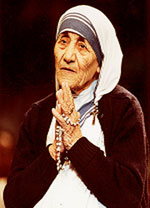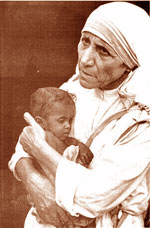Some of the most worthwhile things in life aren’t easy. One of the things I dislike most about “power of positive thinking”-style personal development philosophies (such as “The Secret”) is the implication that if you just have the right attitude and the right state of mind, the rest will just fall into place. I think it causes a lot of hurt and disappointment in people who invest their time, effort, and of course, money into these systems and find themselves, one or two or five years down the line, exactly where they were before.
“You must not have wanted it badly enough,” the authors of these philosophies seem to be saying. “There must still be something wrong with you.”
I don’t think that, ultimately, God or the Spirits or the Universe or the world “provides”. I think a lot of times the world puts obstacles in our way, and no amount of positive thinking makes them go away. And I think that a lot of the people who are “successful”, by whatever standard you want to use, have as much “wrong” with them as a lot of the ones who
aren’t successful. Maybe more.
In any case, wherever the motivation comes from, the things that really make our lives worth living can be quite difficult. (And who knows, maybe thinking positively helps take some of the edge off of doing the hard stuff?) What’s more, they can take a lot of time to do, and even more time to get right. But I think that
doing is the important thing, not the result — throwing yourself into something with all your heart, mind, and soul is the success, not the “growing rich” part.
Here, then, are ten things that are really hard to do but which have an incredible power to make your life better.
1. Start a business
My dad, who has been self-employed almost all his life, used to tell me that “Only jerks work for jerks.” Working for someone else puts you at their mercy and subjects you to their whims — and often their poor management skills. Not only that, but the profit of your labor goes into
their pockets.
Starting a business puts you in control of your work life, and your money. It’s hard — small businesses fail every day. But the rewards of even a failed venture can far outweigh the risk. Just knowing that your failure was the result of your own choices — instead of a decision made at a corporate office a thousand miles away — can be liberating.
2. Organize a group
What makes you passionate? Chances are, being around other people who are passionate about the same thing would make you
even more passionate about it. Often the only thing keeping you and them from coming together is that nobody’s put out a sign saying “Come and talk!” Getting a group going is a tremendous challenge, and very often the personality of the founder leaves a tremendous mark on the group as a whole. Seeing a group grow and take off can be tremendously awarding — but even failing can teach you important things about leadership.
3. Volunteer
I don’t mean spend Thanksgiving at a soup kitchen, though that can often be challenging enough. What I mean, though, is to make a long-term investment in your community by joining school committees, donating three hours a week in a shelter, hosting a monthly read-along at the library, tutoring at-risk children after school, teaching adult literacy classes at a local prison, or any of a million ways to play a role in the lives of people who need you. Perhaps the most pressing need in our society is for people to take an interest in and engage with their communities.
4. Take an active role in your children’s’ activities
Pick one thing your child does and commit yourself to it. Coach their team, become a Brownie leader, spend a weekend day in the workshop with them, buy a bike and ride along with them — make their passions your own. Don’t crowd them — especially if you have teenagers — but show them that you value something they do by giving them your time and interest.
5. Start a family
I don’t mean have kids. That can be all too easy! Make the decision to have a family, which means to give of yourself fully to another person or several people. Risk being vulnerable by sharing your fears, quirks, and failures with someone else; you might find it makes you stronger than ever before.
This transcends marriage and parenthood. There are lots of people who can’t marry because the law prevents it. There are people who can’t have children. These are not the essential ingredients of family. The essential ingredients are love, mutual respect, trust, and open giving. Find (or make) someone you can share that with.
6. Write a book
It feels really, really good to see your name on a book cover, but it feels even better to know that someone, somewhere, might find his or her life changed by something you’ve written. Share your particular expertise, whether it’s story-telling or woodworking, with the world — or just your family. Time isn’t the big issue (though it
is an issue — don’t let the positive thinkists tell you otherwise!) but if you commit yourself to a page a day — a couple hundred words — within a year you’ll have a pretty decent-sized manuscript. That’s something to work with!
7. Learn an art
Take painting lessons, a pottery workshop, a music class, whatever — learn to express yourself and you might find a self worth expressing. Don’t settle for being a “Sunday painter” — devote yourself to an art and master it.
8. Run for office
The world needs smart, dedicated, and upright people to take care of all the fiddly details of making things run. As it happens, running for local office isn’t as challenging as you’d think (which isn’t to say it’s easy) — Michael Moore, the filmmaker, ran for school board while he was still in high school. Just for kicks. And won! It’s fine to have your heart set on the White House or Capital Hill, but try your hand at city councilperson, county registrar, or something closer to home first. And be clean — run for the experience of putting your community on a better path, and not for the power.
9. Take up a sport
Enough with the working out already! Sure, you want to be healthy, but the whole treadmill-running, iPod-listening, 45-minutes-after-work thing is a little anti-social, don’t you think? OK, you want some solitude once in a while — fine. But at least
add a sport, something you do with other people. You’ll be spending time interacting with others, while also developing team-building and leadership skills. And, you might learn something from your fellow players.
10. Set an outrageous goal — and achieve it!
The nine tips above are only a handful of ideas about how to make your life better. Maybe you want to record an album, climb a mountain, make the Hajj (the pilgrimage to Mecca), see 20 countries — don’t just settle for tiny goals, push yourself all the way to the edge and figure out how to make the craziest thing you can think of happen. Yes, you’ll have to learn a lot along the way, and plan months or even years in advance — that’s what makes outlandish goals worthwhile.
I don’t want to suggest that you need to do all these things to be happy — doing just one is quite a handful! But if you’re unhappy with your life, if you want to make a change for the better, you need to think big and you need to be ready to put in the work to make it happen. It’s
easy to “visualize success” and to “think positively”; it’s not so easy to throw yourself into the unknown and make it work. But if you
can make it work, you’ll gain far more than you can imagine.
 Mother Teresa was born in Albania as Agnes Gonxha Bojaxhiu. When just eighteen years old, she attended the religious Order called 'Our Lady of Loreto' in Ireland. She received her spiritual training in Ireland and Darjeeling, India. It was in 1931, that the Mother took the name of Teresa from the French nun Th??e Martin, who was canonized in 1927 with the title St. Th??e of Lisieux. In 1937, Mother Teresa took her vows. She taught for 20 years in Saint Mary's High School in Calcutta, India.
Mother Teresa was born in Albania as Agnes Gonxha Bojaxhiu. When just eighteen years old, she attended the religious Order called 'Our Lady of Loreto' in Ireland. She received her spiritual training in Ireland and Darjeeling, India. It was in 1931, that the Mother took the name of Teresa from the French nun Th??e Martin, who was canonized in 1927 with the title St. Th??e of Lisieux. In 1937, Mother Teresa took her vows. She taught for 20 years in Saint Mary's High School in Calcutta, India.  In 1950, Mother also began to care for lepers. She set up a care centre for the patients of leprosy. In 1965, Pope Paul VI put the Missionaries of Charity under his protection and gave Mother the permission to expand her Order to other countries. Branches of the organization opened almost everywhere around the world to assist lepers, the elderly, the blind, and people living with AIDS. Mother also opened schools and homes for the poor and abandoned children. Her vocation was a message of love. Her work demonstrates that a true conviction is always accompanied by action and that love in action is service.
In 1950, Mother also began to care for lepers. She set up a care centre for the patients of leprosy. In 1965, Pope Paul VI put the Missionaries of Charity under his protection and gave Mother the permission to expand her Order to other countries. Branches of the organization opened almost everywhere around the world to assist lepers, the elderly, the blind, and people living with AIDS. Mother also opened schools and homes for the poor and abandoned children. Her vocation was a message of love. Her work demonstrates that a true conviction is always accompanied by action and that love in action is service.
